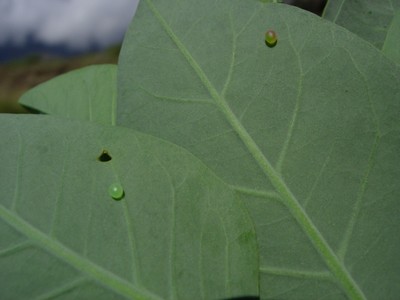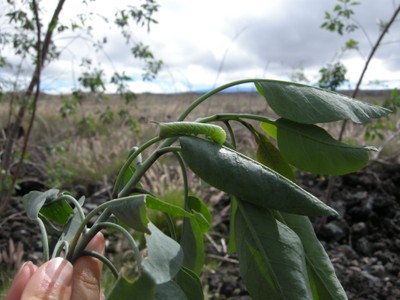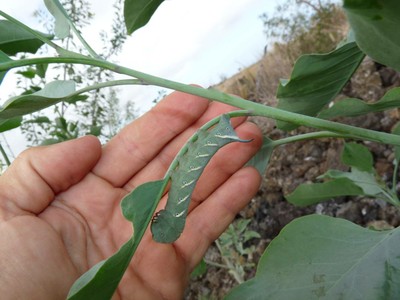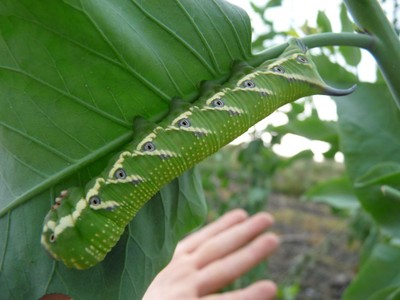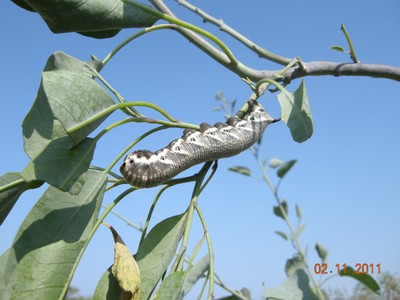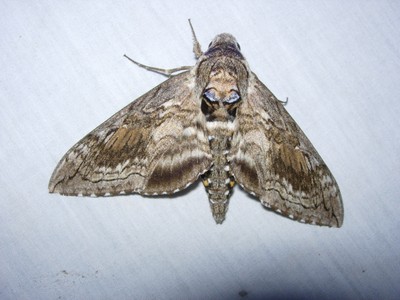Blackburn’s Sphinx Moth

Names
- Blackburn’s Sphinx Moth
- Manduca blackburni
Conservation Status
- Federally listed as Endangered
- State listed as Endangered
- State recognized as Endemic (found nowhere else but Hawaiʻi)
Species Information
Blackburn’s sphinx moth (Manduca blackburni) is one of Hawai‘i’s largest native insects, and is a federally listed endangered species. Its larvae feed on plants in the nightshade family (Solanaceae). Populations of the plant species on which the larva live, ‘aiea, (Nothocestrum spp.) are in decline throughout the State. As a result, the sphinx moth has host-shifted to tree tobacco (Nicotiana glauca), an invasive plant that is spreading across dry, arid landscapes.
Once thought extinct, sphinx moth larvae have been found to be locally abundant on tree tobacco.
Distribution
Originally distributed across all the main Hawaiian Islands, the species was believed to be extinct in the late 1970s. In 1984, the species was rediscovered on East Maui. Additional populations have been found on Kaho‘olawe and the island of Hawai‘i.
Habitat
Historical records indicate that Blackburn’s sphinx moth mostly occurred in coastal, lowland, and dry forests. Human modification of Hawaiian landscapes has greatly reduced these communities; for example, more than 90 percent of Hawaii’s dry forests have been destroyed. Depending on the location and elevation, the composition of the plant species in moth habitat varies considerably. However, some common native plants found in areas where the species occurs include lama (Diospyros sandwiceneses), ‘ohe (Reynoldsia sandwicensis), hao (Raovolfia sandwicensis), ‘āla‘a (Pouteria sandwicensis), āulu (Pisonia sandwicensis and its varieties), ‘a‘ali‘i (Dodonaea viscose), naio (Myoporum sandwicense), and wiliwili (Erythrina sandwicensis). The populations on Maui and Hawai‘i are primarily associated with ‘aiea (Nothocestrum spp.) trees. Perhaps the largest stand of ‘aiea trees in the State are located on Maui in the Kanaio Natural Area Reserve. Other large stands are found on Kaua‘i, O‘ahu, Moloka‘i, Lāna‘i, and the island of Hawai‘i. On Moloka‘i, potential moth habitat consists of mixed-species mesic and dry forests with both native and non-native plants. On Kaho‘olawe, caterpillars currently feed on the non-native tree tobacco, as do populations on Maui and the island of Hawai‘i.
Threats
Historically, habitat loss and degradation due to ranching, introduced plants and animals, human development, and wildfire reduced the quantity and quality of native habitats. Current threats include non-native ants, especially the big-headed ant (Linepithema humile) and several species of parasitic flies and wasps. All species of host plants in the genus Nothocestrum are declining.
Plans & Projects
In order to determine potential adverse impacts to M. blackburni, and to maximize avoidance of take, DLNR DOFAW initiated surveys in 2010 and 2011 for eggs and larvae and documented host plant use to estimate density and distribution of M. blackburni in an area intended to be part of a Habitat Conservation Plan. Data were analyzed to examine how host plant size, leaf density, location, and the presence of predators and/or parasitoids affect the distribution of M. blackburni. These data informed the development of mitigation efforts for M. blackburni. For more information, contact HIP staff.
Additional Resources
For more information and references, see the Blackburn’s Sphinx Moth State Wildlife Action Plan Fact Sheet.
